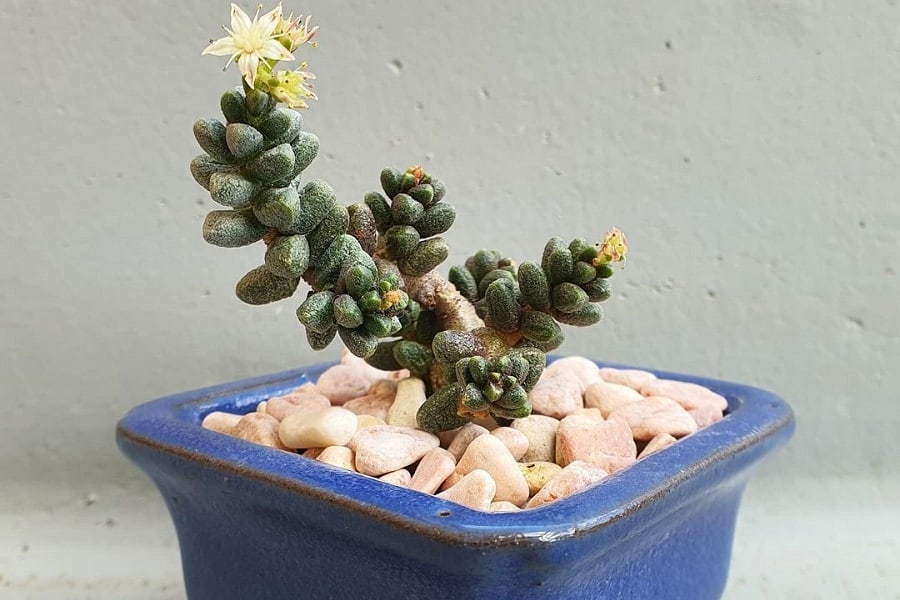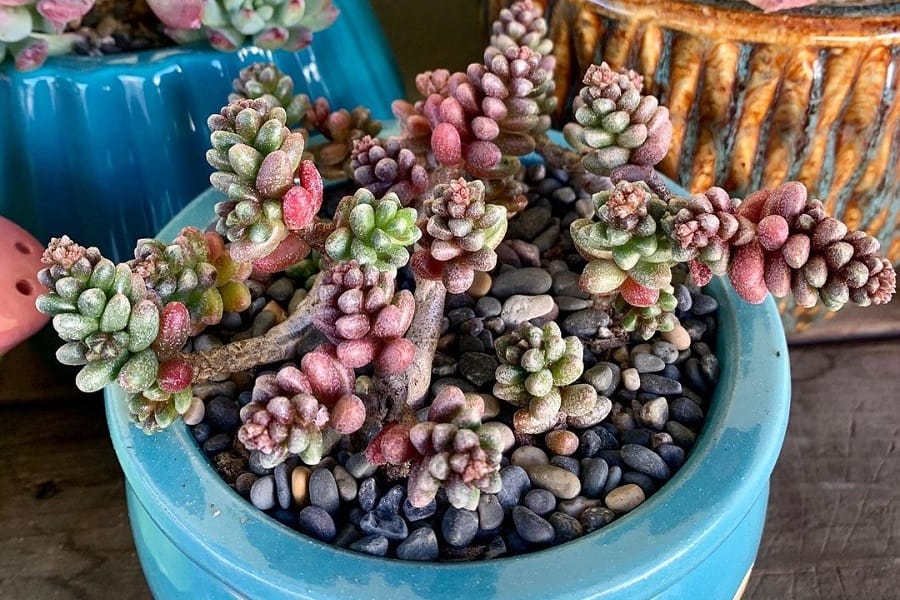Sedum furfuraceum: The Undemanding Succulent That Packs a Punch
Are you searching for a low-maintenance yet eye-catching addition to your garden or indoor plant collection? Look no further than Sedum furfuraceum, a petite but mighty succulent that demands very little care while delivering a vibrant pop of color and texture. Get ready to be captivated by this undemanding gem!

Contents
About Sedum furfuraceum
Also known as the “bonsai sedum” or “woolly sedum,” this perennial succulent hugs the ground, reaching a maximum height of just 4 inches when fully mature. Its compact size and spreading habit make it an ideal choice for rock gardens, containers, or as a groundcover. But don’t let its stature fool you – Sedum furfuraceum packs a visual punch with its distinctive foliage and delicate blooms.
The fleshy leaves, resembling tiny green and purple eggs coated in a white, powdery bloom, form tight rosettes that create a carpeting effect. And when it blooms, you’ll be treated to a display of dainty pink and white flowers that attract pollinators like bees and butterflies.
Related Post:
130+ Attractive Sedum Varieties With Pictures
How To Care For Sedum furfuraceum
One of the biggest draws of this succulent is its easy-going nature. Here’s what you need to know to keep your Sedum furfuraceum thriving:
Light
Sedum furfuraceum loves basking in the sun, requiring at least 6 hours of direct sunlight daily. If grown indoors, place it near a sunny window or use a grow light to provide the necessary brightness.
Water
This drought-tolerant plant only needs watering once the soil has completely dried out. During the growing season (spring to fall), aim for weekly waterings, increasing the frequency if temperatures soar. In winter, reduce watering to allow the plant to rest.
Soil

Like most succulents, Sedum furfuraceum prefers a well-draining soil mix. Choose a commercial succulent soil, or create your own by combining 60% succulent soil with 40% coarse materials like perlite, gravel, or lava rocks to enhance drainage.
Temperature and Humidity
Sedum furfuraceum is cold-hardy, tolerating temperatures as low as -20°F (-29°C) in USDA hardiness zones 5a to 9b. Indoors, it prefers temperatures between 60-70°F (15-21°C) during the winter months. As for humidity, this succulent thrives in average household conditions.
Fertilizer
Like many succulents, Sedum furfuraceum prefers lean soil conditions. If desired, you can apply a balanced, succulent-specific fertilizer at half-strength during the growing season.
Potting and Repotting
When grown in containers, repot your Sedum furfuraceum every 2-3 years, using a well-draining succulent mix. Ensure the pot has ample drainage holes to prevent waterlogging.
Pests and Problems
This resilient plant is relatively pest- and disease-free. However, keep an eye out for mealybugs, spider mites, or fungal infections, which can occur if the plant is overwatered or lacks proper air circulation.
Pruning
Regular pruning isn’t necessary for Sedum furfuraceum, but you can remove any dead or damaged foliage in early spring to tidy up its appearance. Pinching back new growth will encourage bushier, more compact growth.

How to Propagate Sedum furfuraceum
Sedum furfuraceum can be propagated through division, leaf cuttings, stem cuttings, or seeds, with division being the simplest method.
Division:
- In early spring, carefully dig up the parent plant and separate it into sections, ensuring each section has some roots and new growth buds.
- Replant the divisions at the same depth as before, water well, and care for them as usual.
Leaf Cuttings:
- Gently twist off a few healthy leaves from the mother plant, allowing the ends to callus over for a few days.
- Fill a well-draining container with succulent soil mix.
- Plant the calloused leaf cuttings just below the soil surface, spacing them a few inches apart.
- Lightly water and provide bright, indirect light until roots and new growth appear.
Stem Cuttings:
- Using clean scissors or pruners, take 2-4 inch stem cuttings from a healthy Sedum furfuraceum plant.
- Allow the cut ends to callus over for a few days before planting.
- Fill a well-draining container with succulent soil mix.
- Plant the calloused stem cuttings vertically, burying about a third of the stem in the soil mix.
- Water sparingly until roots form and new growth appears.
Seeds:
- Sow fresh Sedum furfuraceum seeds in a well-draining seed-starting mix.
- Cover the seeds lightly with soil and keep the mix consistently moist until germination, which can take several weeks.
- Once seedlings appear, provide bright light and allow the soil to dry slightly between waterings.
With its captivating foliage, dainty blooms, and undemanding nature, Sedum furfuraceum is a must-have for any succulent enthusiast or gardener seeking a low-maintenance showstopper.
